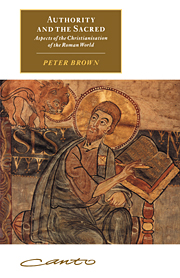Refine search
Actions for selected content:
23990 results in Ancient history
1 - FOREWORD: VISIONS OF CONSTANTINE
-
- Book:
- Remembering Constantine at the Milvian Bridge
- Published online:
- 03 May 2011
- Print publication:
- 29 April 2011, pp 1-18
-
- Chapter
- Export citation
10 - BACK WORD: THE BRIDGE
-
- Book:
- Remembering Constantine at the Milvian Bridge
- Published online:
- 03 May 2011
- Print publication:
- 29 April 2011, pp 253-258
-
- Chapter
- Export citation
7 - ROME AFTER THE BATTLE
-
- Book:
- Remembering Constantine at the Milvian Bridge
- Published online:
- 03 May 2011
- Print publication:
- 29 April 2011, pp 155-218
-
- Chapter
- Export citation
Contents
-
- Book:
- Remembering Constantine at the Milvian Bridge
- Published online:
- 03 May 2011
- Print publication:
- 29 April 2011, pp vii-viii
-
- Chapter
- Export citation
3 - ECCLESIASTICAL HISTORIES
-
- Book:
- Remembering Constantine at the Milvian Bridge
- Published online:
- 03 May 2011
- Print publication:
- 29 April 2011, pp 33-55
-
- Chapter
- Export citation
8 - Conclusions
-
- Book:
- The Politics of Inheritance in Romans
- Published online:
- 03 May 2011
- Print publication:
- 21 April 2011, pp 229-243
-
- Chapter
- Export citation
1 - Introduction: the politics of inheritance?
-
- Book:
- The Politics of Inheritance in Romans
- Published online:
- 03 May 2011
- Print publication:
- 21 April 2011, pp 1-19
-
- Chapter
- Export citation
Contents
-
- Book:
- The Politics of Inheritance in Romans
- Published online:
- 03 May 2011
- Print publication:
- 21 April 2011, pp ix-x
-
- Chapter
- Export citation
5 - “Riches for the world”: inheritance in Romans 11:1
-
- Book:
- The Politics of Inheritance in Romans
- Published online:
- 03 May 2011
- Print publication:
- 21 April 2011, pp 136-171
-
- Chapter
- Export citation
Preface
-
- Book:
- The Politics of Inheritance in Romans
- Published online:
- 03 May 2011
- Print publication:
- 21 April 2011, pp xi-xi
-
- Chapter
- Export citation
2 - Some features of Greco-Roman society in the symbols, ritual and literature of Paul's time
-
- Book:
- The Politics of Inheritance in Romans
- Published online:
- 03 May 2011
- Print publication:
- 21 April 2011, pp 20-57
-
- Chapter
- Export citation
4 - Suffering “conquerors”: inheritance in Romans 8:17–39
-
- Book:
- The Politics of Inheritance in Romans
- Published online:
- 03 May 2011
- Print publication:
- 21 April 2011, pp 102-135
-
- Chapter
- Export citation
Index
-
- Book:
- The Politics of Inheritance in Romans
- Published online:
- 03 May 2011
- Print publication:
- 21 April 2011, pp 265-268
-
- Chapter
- Export citation
6 - “Lords” over all the world: the language of inheritance in Galatians
-
- Book:
- The Politics of Inheritance in Romans
- Published online:
- 03 May 2011
- Print publication:
- 21 April 2011, pp 172-206
-
- Chapter
- Export citation
Frontmatter
-
- Book:
- The Politics of Inheritance in Romans
- Published online:
- 03 May 2011
- Print publication:
- 21 April 2011, pp i-viii
-
- Chapter
- Export citation
3 - Promising the world: inheritance in Romans 4:13–25
-
- Book:
- The Politics of Inheritance in Romans
- Published online:
- 03 May 2011
- Print publication:
- 21 April 2011, pp 58-101
-
- Chapter
- Export citation
Bibliography
-
- Book:
- The Politics of Inheritance in Romans
- Published online:
- 03 May 2011
- Print publication:
- 21 April 2011, pp 244-264
-
- Chapter
- Export citation
List of abbreviations
-
- Book:
- The Politics of Inheritance in Romans
- Published online:
- 03 May 2011
- Print publication:
- 21 April 2011, pp xii-xiv
-
- Chapter
- Export citation
7 - Inheritance in 1 Corinthians and Colossians
-
- Book:
- The Politics of Inheritance in Romans
- Published online:
- 03 May 2011
- Print publication:
- 21 April 2011, pp 207-228
-
- Chapter
- Export citation

Authority and the Sacred
- Aspects of the Christianisation of the Roman World
-
- Published online:
- 18 April 2011
- Print publication:
- 28 August 1997
